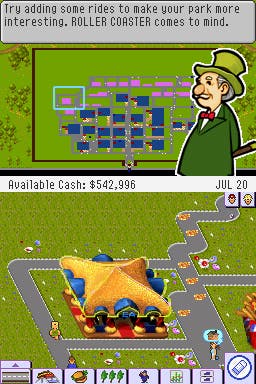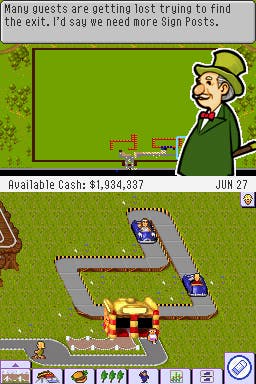Theme Park DS
I theme to have played this before.
"The definition of insanity," my friend told me, as he stood on a petrol station forecourt watching me wrestle a wing mirror onto my car using packing tape and rubber bands, "is doing the same thing again and expecting a different result." "I seriously doubt that is the actual medical definition of insanity," I responded grumpily.
"But perhaps it applies to Theme Park DS!" I added, several hours later, continuing my unbroken streak of only thinking of something witty to say after the fact. Well, something to say, anyway. As to wit, your mileage may vary. Remember to check your mirrors.
Like a real theme park, the attraction of playing the '90s PC classic that helped make Peter Molyneux's Bullfrog such a household name (well, a stinky bedroom name) is being taken for a ride and enjoying it so much that you don't notice that you're standing in vomit, or being forced to click a tiny little arrow 43 times in a row to change a number. It's a management sim that involves building up a simple theme park while you're also juggling a range of variables, which determine how much money each bit makes and whether the people coming through the turnstyles have any fun. It's about as realistic as candy floss, but that's not something you'll be worried about.

Nor will the conversion cause you much concern. The DS version has been put together by EA's Japanese studio [it has one? - unaware Ed], which is a bit weird given the game's British pedigree, and the fact that the only developer left in Britain that EA doesn't employ is Peter Molyneux. Leaving that aside, these fellows must be given more work. Using the d-pad or face buttons to move the camera up, down, left and right, and the stylus as a replacement for the PC mouse, you're able to quickly lay down pathways, add a few rides, hire staff, and set about the business of squeezing margins and giving the people what the polls tell you they want. It's a welcome change from the fruits of the usual PC-to-DS conversion process, which seems to involve setting fire to your hair and then trying to put it out by hitting yourself repeatedly in the head with the development kit.
Information is shared across both screens, meaning that you're rarely overwhelmed. Your theme park usually sits on the touch-screen with an overhead map shown above, but clicking on ride options and other menus quickly swaps their positions so you can tweak things with the stylus.
A row of icons along the bottom of the screen allows easy access to placement tools, finance reports, staff pages and of course the all-important arrow icons that allow you to charge $71 for a Coke and add $100 to the admission price at the drop of a hat. The drop of a hat. Hat hat hat. The main problem with the interface is that the little arrow buttons are a bit small and fiddly to hit. You'll soon adjust though, and it's immediately easy to deploy new rides, sign-posts pointing to them, queueing areas, concession stands, workers and entertainers, and even the odd public convenience.
One slight peculiarity is the game's use of mini-games, like the one that involves negotiating with the trade unions. "Uh oh," says your little on-screen tutor, and he's right. Dragging a hand partway across the screen to try and meet at a mutually agreeable percentage doesn't even sound alright on paper. Fortunately it doesn't distract you too long from massaging profits, flicking obsessively between pages of easily-found information to work out where next to expand, or tapping on visitors trying to find out what they're thinking. Once you become proficient - and it won't take long, thanks to an effective tutorial - you can even play the stock market.

There are problems, but they're mostly 1994's fault. You can't rotate the camera around your park, meaning that it's impossible to see what's going on behind certain rides, while the repair men responsible for ride maintenance seem loath to actually do any work. Whether this is down to dodgy path-finding or not enough of our hard-working European neighbours coming in and doing our jobs better is unclear, largely because the DS sprites are fairly unremarkable. We also experienced graphical glitches here and there, including some intermittent flickering, and a visitor stuck in a sumo wrestler.
The bigger problem though is that Theme Park is so old that it's gotten all moody and started looking at girls' bums. PC owners have moved on to games like RollerCoaster Tycoon that allow you to assemble your own custom rides, and then moved on again to ones that let you actually ride around in them, too. Making a park in a sandbox mode and then doing it again one day isn't enough now, either: we need missions, variety. Being able to swap profiles using Wi-Fi is a nice touch, but we don't need to be touched, we need to be manhandled.
PC owners from the '90s wouldn't go back to boring old Theme Park now, much as they loved it at the time, because while they know that it's as good a port as you'll find outside my trusty hipflask, and an excellent timesink, they also know that if you go back on the strength of nostalgia you'll discover that it's one of those rare occasions where doing something again can bring about a different result. And so they play it safe and buy Slitherlink instead. Probably. Will you?

